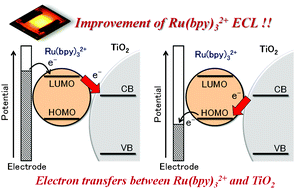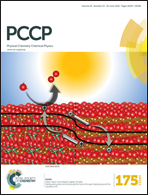Why were alternating-current-driven electrochemiluminescence properties from Ru(bpy)32+ dramatically improved by the addition of titanium dioxide nanoparticles?
Abstract
Electrochemiluminescence (ECL) is a phenomenon in which light is emitted from the excited state of a redox-active material generated by electrochemical reactions. Among light-emitting devices, ECL devices have various advantages in terms of structure and ease of fabrication, and therefore, they are expected to be next-generation emitting devices. In this study, we introduced rutile-type titanium dioxide nanoparticles (TiO2 NPs) in a Ru(II)-complex-based electrolyte to improve the emission properties of an alternating current (AC)-driven ECL device. The properties of the ECL device with TiO2 NPs were greatly improved (emission luminescence, 165 cd m−2; half-life time, 1000 s) compared to a previously reported AC-driven ECL device without nanoparticles. To determine how TiO2 NPs helped in achieving high emission luminescence and long-term stability, we measured the optical and electrochemical properties of the Ru(bpy)32+-based ECL solution in detail. The PL intensity of Ru(bpy)32+ was increased by adding TiO2 NPs, which indicated that the suppression of non-radiative quenching of the complex's excited states could improve the ECL intensity. With respect to the enhanced stability, electron transfers between Ru(bpy)32+ and TiO2 were suggested by detailed electrochemical measurements. These electron transfers occurred from the reduced Ru(bpy)32+ species to the TiO2, and subsequently, from the TiO2 to the oxidized Ru(bpy)32+ species. Such electron transfers are thought to improve the balance of the redox reactions in the ECL device, leading to long-term stability.


 Please wait while we load your content...
Please wait while we load your content...